| Administrative divisions of Mongolia |
|---|
| First-level |
| Second-level |
| Third-level |
|
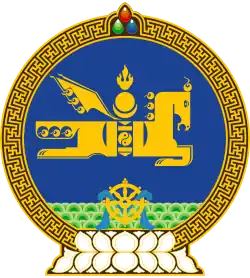 |
|---|
A district (Mongolian: сум, ᠰᠤᠮᠤ, sum, pronounced [sʰo̙m]; lit. "arrow"), is a second level administrative subdivision of Mongolia. The 21 provinces of Mongolia are divided into 330 sum.[1]
On average, each district administers a territory of 4,200 km2 (1,600 sq mi) with about 5,000 inhabitants, primarily nomadic herders. Its total revenue is 120 million Tögrög, 90% of which comes from national subsidies.
Each district is again subdivided into bags (brigades; sometimes spelled baghs[2]). Most bags are of an entirely virtual nature. Their purpose is to sort the families of nomads in the district into groups, without a permanent human settlement.
Officially, and occasionally on maps, many district seats (sum centers) bear a name different from that of the district. However, in practice the district seat (sum center) is most often referred to under the name of the district, to the point of the official name of the district seat (sum center) being unknown even to the locals.

Arkhangai Province
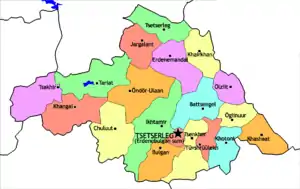
- 19 sum
Bayan-Ölgii Province

- 14 sum
Bayankhongor Province

- 20 sum
Bulgan Province
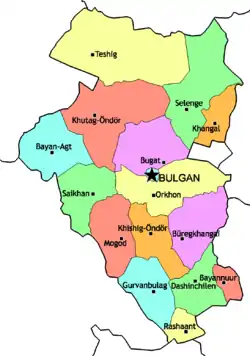
16 sum
Darkhan-Uul Province

- 4 sum
Dornod Province

- 14 sum
Dornogovi Province

- 14 sum
Dundgovi Province
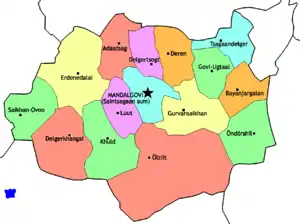
- 15 sum
Govi-Altai Province

- 18 sum
Govisümber Province
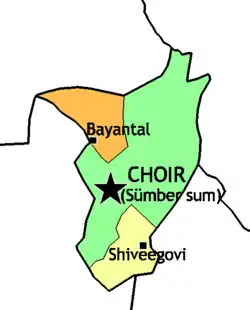
- 3 sum
Khentii Province
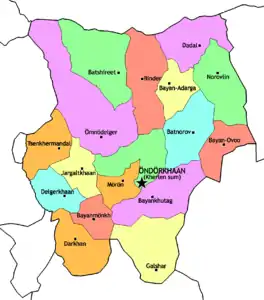
- 17 sum
Khovd Province
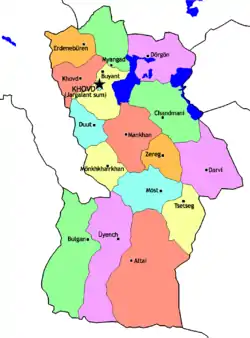
- 17 sum
Khövsgöl Province
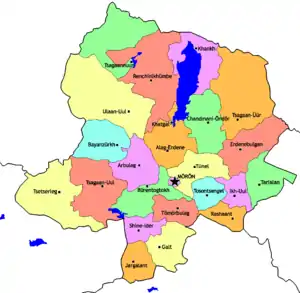
- 23 sum
Ömnögovi Province
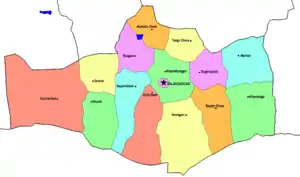
- 15 sum
Orkhon Province

- 2 sum
Övörkhangai Province
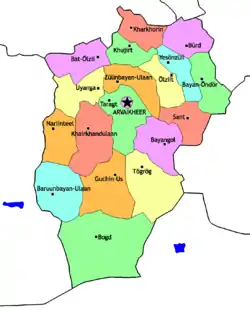
- 19 sum
Selenge Province

- 17 sum
Sükhbaatar Province

- 13 sum
Töv Province

- 27 sum
Uvs Province

- 19 sum
Zavkhan Province
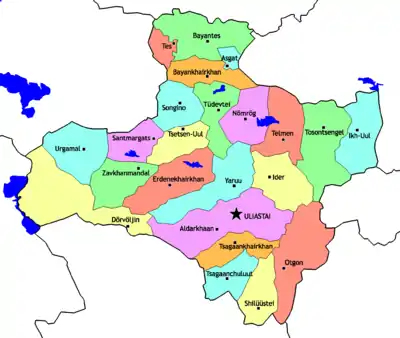
- 24 sum
References and external links
- ↑ "21 аймгийн 330 сум, нийслэлийн 152 хороо болон хилийн чанад дахь ДТГ-ын бүртгэлийн үйл ажиллагаанд ашиглаж буй тоног төхөөрөмжийг шинэчлэнэ". burtgel.gov.mn. Retrieved 2023-09-21.
- ↑ Montsame News Agency. Mongolia. 2006, Foreign Service office of Montsame News Agency, ISBN 99929-0-627-8, p. 46